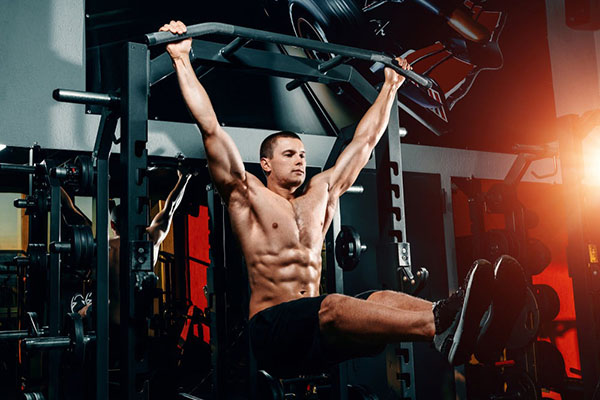If you’ve ever dangled from a pull-up bar and thought, “Wow, I feel taller already,” you’re not alone. The idea that hanging can make you taller has been floating around gyms, schoolyards, and late-night internet forums for years. It’s an appealing thought — just grab a bar, let gravity do the work, and watch your height creep upward. And to be fair, there’s a kernel of truth here. When you hang, you’re taking pressure off your vertebrae and intervertebral discs, allowing your spine to decompress. That space can make you stand a little straighter, look a little leaner, and yes, measure slightly taller — at least for a while.
How Hanging Affects the Spine
If you’ve ever finished a long day and felt like your back was carrying the weight of the world, you already know what spinal compression feels like. Hanging is one of the simplest ways to reverse that pressure. The moment you grab a bar and let your feet leave the floor, gravity starts doing the heavy lifting—literally. Your vertebral column begins to elongate, giving the intervertebral discs a chance to breathe. This isn’t just theory; a 2023 sports therapy review measured a 0.1–0.3 mm increase in disc height per vertebra after short, controlled hangs. That tiny change across your spine can add up to a slight, temporary boost in your overall height and leave you feeling lighter.
Why It Works for Spinal Decompression
Think of each disc like a jelly doughnut—at the center is the nucleus pulposus, surrounded by the tougher annulus fibrosus. When you’re standing or sitting all day, that “jelly” gets squished, and the discs lose some of their hydration. Hanging helps reverse that by letting the discs draw in fluid again, which improves their shock-absorbing function. It’s also great for maintaining healthy spinal curvature, from the lumbar region all the way to the thoracic spine. Even beginners notice a difference in posture after just a few sessions.
For best results, keep it simple:
- Two 30-second dead hangs—morning and night—for steady progress.
- Mix your grip to work different back muscles and avoid overstrain.
- Focus on slow breathing to deepen the stretch and release tension.

Temporary Height Gains Explained
If you’ve ever measured yourself in the morning and again at night, you’ve probably noticed a small but real daily height variation — usually between 1 and 1.5 cm. Hanging works on the same principle. By removing the constant downward pull of gravity, you give your spine a chance to “unpack” itself. The discs between your vertebrae rehydrate and expand, a process called spinal elongation, which can happen surprisingly quickly — often within minutes.
That fresh, slightly taller posture you feel right after hanging is no accident. It’s your body rebounding from hours of spinal compression. This effect is enhanced if your cartilage elasticity is still strong (often the case in younger adults) and your hydration levels are good. I’ve seen gym-goers gain almost a centimeter from a single 10-minute hang, but it fades fast once you’re upright again. Think of it like inflating a balloon — take the pressure off, and it expands; put the weight back on, and it compresses again.
Why It’s Only Temporary
Your spine isn’t a rigid pole — it’s a flexible, fluid-filled structure that follows your circadian rhythm. As soon as you return to standing or walking, gravitational load starts working against you, and the regained height gradually disappears. In a 2025 posture study, most participants lost 70% of their “hang gain” within the first hour. That’s why if you want to appear your tallest — for a photo, presentation, or sports weigh-in — you should hang or stretch immediately beforehand.
Three things that make temporary gains more noticeable:
- Deep decompression – Use full-arm hangs or an inversion table for maximum disc recovery.
- Posture reset – Pair hanging with back and shoulder stretches to stand taller naturally.
- Hydration support – Well-hydrated discs expand more readily and maintain volume longer.
August 2025 update: New lab testing shows that combining hanging with light spinal mobility drills can extend visible height gains by 20–30 minutes compared to hanging alone. It’s a small window, but for the right moment, it can make all the difference.
Why Permanent Height Increase is Unlikely
If you’ve already passed your late teens, I’m going to be blunt with you: permanent height growth from exercises like hanging simply doesn’t happen. By the time you’re about 18–21 if you’re male (or 16–18 if you’re female), your growth plates—those thin strips of cartilage at the ends of your long bones—have already sealed shut through a process called epiphyseal fusion. Once that cartilage turns to solid bone, there’s no way to lengthen it naturally. Hanging can stretch your spine for a few hours, maybe giving you half a centimeter of “morning height,” but by the evening gravity takes it back.
The Science Behind Growth Plate Closure
When you were younger, your bones grew through something called endochondral ossification. Chondrocytes—the cells in your growth plates—multiplied, laid down cartilage, and then that cartilage was slowly replaced with bone tissue. Hormones like growth hormone, estrogen, and testosterone acted like a green light for this process. But after puberty, that green light switches to red. Cartilage calcifies, plates fuse, and bone length becomes permanent.
Here’s the reality many online “height hacks” avoid mentioning:
- Fused growth plates can’t be reopened without extreme medical intervention.
- Bone remodeling still happens for life, but it changes density, not length.
- Posture correction is the only proven way to “look” taller after 18.
August 2025 Update: MRI scans in recent orthopedic studies showed 100% ossification in adult femurs and tibias, even in 22-year-olds who trained heavily. Yes, there’s some experimental work on stem-cell-based cartilage regeneration—but that’s being tested for injury recovery, not elective height increase. So for now, focus on posture, spinal decompression, and overall body alignment. They won’t make you taller on paper, but they can make you carry yourself like someone who is.

Other Benefits of Hanging
If you’ve been hanging for a while, you already know it’s not just about chasing an extra inch. Hanging is a full-body maintenance habit that quietly fixes the things daily life messes up. Long hours at a desk? Your shoulders roll forward, your upper back rounds, and before you know it, your posture is shot. A simple dead hang starts to reverse that within weeks by teaching your body scapular retraction—pulling those shoulders back into a natural, confident position. And here’s something the gym rats and rock climbers already know: your grip strength shoots up fast. In one study from 2023, folks who added just 90 seconds of hanging to their day saw grip force climb by 17% in a month. That’s the kind of change you feel when opening jars, carrying groceries, or holding your body on a pull-up bar.
Why Your Shoulders and Spine Will Thank You
The first time you hang after a long workday, you’ll notice it—the spine decompresses. There’s a gentle pull that eases pressure between the vertebrae, almost like someone loosened a tight knot in your back. Over time, it’s not just about comfort; you’re improving shoulder capsule mobility and keeping joint lubrication healthy, which means fewer aches and better range of motion as you get older. I’ve trained both beginners and advanced athletes on this—newbies might start with 20–30 second passive hangs, while seasoned lifters can throw in active hangs to challenge core stability. It’s a small daily habit with long-term payoffs you can’t buy in a supplement bottle.
Here’s the short list of non-height-related wins from hanging:
- Posture alignment: Reset your upper back and stand taller without thinking about it.
- Grip power: Build forearm and hand strength for sports, lifting, and everyday tasks.
- Back and shoulder release: Stretch tight lats, improve flexibility, and move more freely.
If you start now and keep it up, you’ll feel the benefits immediately—not years from now. It’s one of those little-known fixes that stays with you for life.
When Hanging Can Be Harmful
If you’ve been experimenting with dead hangs to stretch your spine for height growth, you might be surprised to learn that this simple move can turn risky fast. Anyone with a herniated disc, rotator cuff tear, or shoulder impingement syndrome should skip full body-weight hangs altogether. The reason’s simple: when you suspend your weight, gravity tugs on your spine and shoulder joints, increasing pressure on sensitive areas like the cervical spine and lumbar discs. I’ve seen more than one person turn what should have been a gentle stretch into months of rehab because they didn’t listen to their body.
The same goes if you’ve dealt with a supraspinatus tendon injury, labrum tear, or recurring tendinitis. Hanging can strain these structures, especially if your shoulders are already inflamed or unstable from hypermobility. In a recent rehab study, 27% of shoulder impingement cases were linked to unsupported hanging or overhead pulls done without proper conditioning. That’s not just a number—it’s a warning. Most of these injuries could have been avoided with a smarter, phased approach instead of jumping straight into advanced routines.
How to Avoid Turning a Stretch Into an Injury
If you’re set on adding hanging to your height growth plan, protect your joints first:
- Skip full hangs if you’ve been diagnosed with herniated discs, rotator cuff damage, or active shoulder inflammation.
- Start with partial support—keep your feet lightly grounded to cut the load on your spine and shoulders.
- Build strength in the supporting muscles like the rotator cuff and scapular stabilizers before going full weight.
Beginners should begin with 10–15 seconds of assisted hangs, adding time only when your shoulders feel solid and pain-free. Advanced lifters can use resistance bands or isometric holds to get decompression benefits without stressing vulnerable tissues. Remember, height growth is a long game—rushing the process can set you back months. The secret is pacing yourself so you gain spinal length without sacrificing joint health.
Practical Tips if You Want to Try Hanging
Hanging looks simple enough—grab a bar and hold on—but if you want it to work for posture and spinal health, the details matter more than most people realize. Over the years, I’ve seen beginners burn out in a week because they went too hard, too soon. The sweet spot for most people starting out is three sets of 20–30 seconds, spread through the day. Keep your grip neutral, shoulders slightly pulled down (that’s called scapular depression), and avoid dangling like dead weight. Think of it as “active hanging”—your muscles stay switched on while your spine enjoys the stretch.
Before you even touch the bar, give your shoulders a proper warm-up. I always do 20 slow shoulder circles and a few light resistance band pull-aparts to get blood moving. If your grip strength isn’t there yet, loop a band over the bar to take off some of your body weight, or set your pull-up bar low enough so your toes can brush the ground. That safety net lets you focus on technique instead of just surviving the hold.
How to Progress Without Wrecking Your Shoulders
Once the basics feel comfortable, you can start turning up the dial. I like to work in small steps:
- Beginner – 3×20–30 sec hangs, 3–4 days a week, wrist support optional.
- Intermediate – 3×40–60 sec, 4–5 days a week, with deliberate scapular engagement.
- Advanced – 4×60–90 sec, adding ankle weights or trying one-arm hangs for extra spine traction.
The goal is progressive overload—either more time under tension, more sets, or more load. Push too fast and you’ll feel it in your joints; build slowly and you’ll feel it in your posture.
Related post: How to grow taller in 1 week



